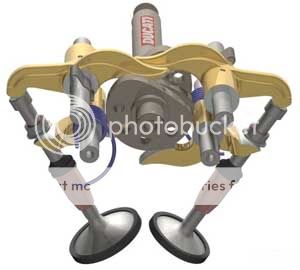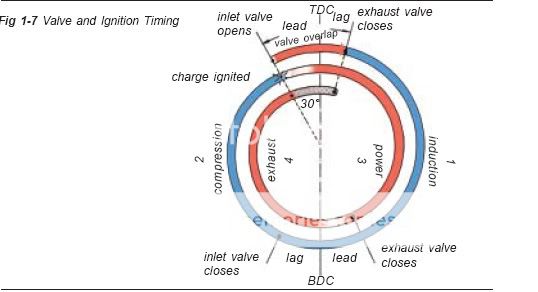To describe the modified valve and ignition timings, the following terms are
used:
a. “Valve lead” means that the inlet valve opens before the piston has reached
TDC, and that the exhaust valve opens before BDC.
b. “Valve lag” means that the inlet valve closes after the piston has passed
BDC and that the exhaust valve closes after the piston has passed TDC.
c. “Valve overlap” means that both inlet and exhaust valves are open together.
It is a period when the inlet valve opens before TDC and the exhaust valve
does not close until after TDC (see Fig 1-7).
d. “Ignition advance” describes the fact that ignition occurs before the piston
reached TDC on the compression stroke.
(Note that timings of all these events (ie ignition, and the valves opening or closing)
are all measured in degrees of crankshaft rotation - eg “120 before TDC” etc.)
12. Increasing the efficiency of the engine by using valve lead, lag and overlap
is made possible by a natural feature of the piston engine called “ineffective crank
angle”. This means that near TDC and BDC a fairly large rotation of the crankshaft
causes only a small linear movement of the piston.
13. The valves are spring-loaded into the closed position and are opened
THE PISTON ENGINE
by a mechanism geared to the crankshaft. The one shown at Fig 1-4 is a camoperated
pushrod, but there are other methods. The mechanism operates at half the crankshaft
speed so that each valve opens and closes only once for each two revolutions of
the crankshaft. As shown earlier the valves are timed to open and close at special
positions of the crankshaft and piston, measured in degrees of crankshaft rotation.
For example, in Fig 1-7 the inlet valve leads 300 before TBC and the exhaust valve
lags 150 after TDC. The inlet valve lead ensures that the maximum charge of mixture
enters the cylinder on the induction stroke, and the exhaust valve lag ensures
maximum scavenging of the burnt gases on the exhaust stroke.





